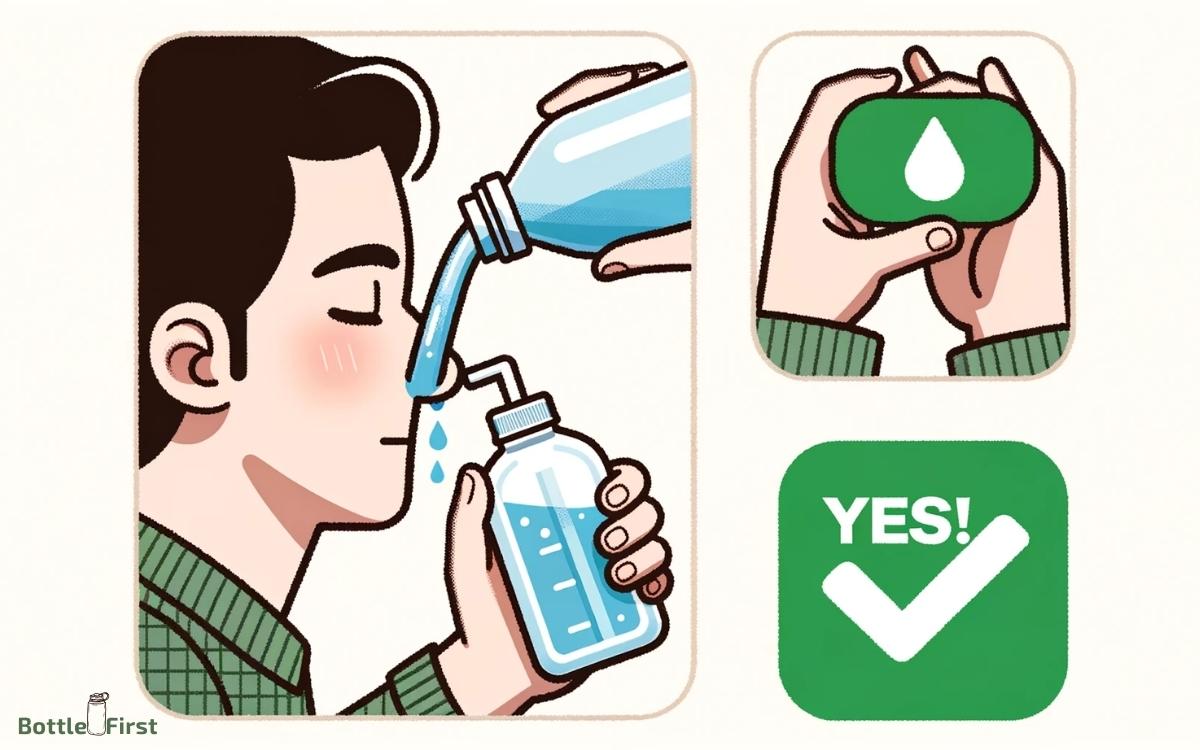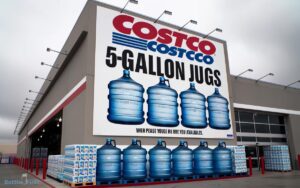Can I Use a Water Bottle As a Neti Pot? Yes!
Using a water bottle as a neti pot is possible, but it requires careful consideration to ensure it is done safely and effectively.
The water bottle must be clean, and the water used should be distilled, sterile, or previously boiled to prevent infections.
Nasal irrigation with a neti pot is a common practice to alleviate symptoms of sinus congestion, allergies, and colds.
A neti pot typically has a specific shape and size to control the flow of water. If a neti pot is not available, a water bottle can be used with some modifications.
The key is to ensure the water bottle’s spout can fit comfortably in one nostril and that it can provide a gentle flow of water.
- The water bottle must be thoroughly cleaned and sanitized.
- Use only distilled, sterile, or previously boiled and cooled water.
- The water temperature should be lukewarm, similar to body temperature.
- Add a proper saline solution to the water to mimic the body’s natural fluids.
When considering a water bottle for nasal irrigation, prioritize safety and hygiene to avoid complications. Ensure the bottle is suitable for this purpose and follow guidelines for a safe and hygienic experience.

Key Takeaway
Neti Pot Vs. Water Bottle
The use of a dedicated neti pot, specifically designed for nasal irrigation, is generally recommended over using a water bottle for this purpose due to its specialized design and functionality.
Neti pots are crafted to deliver a gentle and controlled flow of saline solution into the nasal passages, ensuring effective irrigation and cleansing. Their spouts are designed to fit comfortably into the nostril, allowing for easy and precise administration of the solution.
Additionally, the shape and angle of the neti pot facilitate optimal positioning for efficient nasal rinsing. While a water bottle may seem like an alternative, it lacks the specific features required for safe and effective nasal irrigation.
Therefore, for those seeking innovative and reliable nasal care, investing in a purpose-built neti pot is the recommended choice.
Pros and Cons of Using a Water Bottle
While a water bottle may offer a makeshift solution for nasal irrigation, it lacks the specialized design and functionality of a dedicated neti pot, thus presenting several limitations and drawbacks.
One of the primary drawbacks of using a water bottle for nasal irrigation is the lack of a suitable spout or nozzle, which is essential for directing the flow of saline solution into the nasal passages.
Additionally, the pressure exerted by squeezing a water bottle may be difficult to control, potentially causing discomfort or injury.
Furthermore, the size and shape of a water bottle may not be ergonomic for nasal irrigation, leading to inefficiencies and potential spillage.
Safety Considerations
When considering safety in nasal irrigation, it is important to recognize the potential risks associated with using a water bottle instead of a dedicated neti pot.
While using a water bottle for nasal irrigation may seem innovative, there are several safety considerations to keep in mind:
- Risk of injury: The rigid edges of a water bottle may cause nasal irritation or injury.
- Inadequate sterilization: Water bottles may not be designed for sterilization, increasing the risk of bacterial or fungal contamination.
- Improper flow control: Water bottles may not provide the controlled flow required for safe and effective nasal irrigation.
- Chemical leaching: Some plastic water bottles may leach harmful chemicals when in contact with warm saline solution.
- Lack of ergonomic design: Water bottles may lack the ergonomic design necessary for comfortable and safe nasal irrigation.
It is essential to prioritize safety and effectiveness when considering alternative tools for nasal irrigation.
How to Use a Water Bottle for Nasal Irrigation
Considering the safety considerations discussed previously, it is occasionally possible to use a water bottle for nasal irrigation, but it is important to proceed with caution and adhere to specific guidelines.
To use a water bottle for nasal irrigation, start by thoroughly cleaning the bottle and ensuring that it is completely dry.
Next, prepare a saline solution by mixing distilled, sterile water with non-iodized salt. The ratio should be around 1 teaspoon of salt per 16 ounces of water.
Once the saline solution is ready, fill the water bottle with it.
Then, lean over a sink and tilt your head to one side. Gently insert the nozzle of the water bottle into one nostril and squeeze the bottle, allowing the saline solution to flow through your nasal passages and out the other nostril.
Always remember to use gentle pressure to avoid discomfort or injury.
Tips for Using a Water Bottle Safely
To ensure safe usage, always thoroughly clean and completely dry the water bottle before filling it with the saline solution for nasal irrigation. This will help prevent the introduction of harmful bacteria or other contaminants into the nasal passages.
Here are some additional tips for using a water bottle safely:
- Use a bottle with a nozzle that fits comfortably in the nostril to ensure a proper flow of the saline solution.
- Check the water bottle for any signs of damage or wear and tear before each use to avoid potential leaks or breakage.
- Do not share your water bottle for nasal irrigation to prevent the spread of infections or illnesses.
- Store the water bottle in a clean and dry place when not in use to maintain its hygiene and integrity.
- Replace the water bottle regularly to ensure it remains in good condition for safe and effective nasal irrigation.
Alternatives to Using a Water Bottle
An alternative to using a water bottle for nasal irrigation is using a dedicated neti pot. Neti pots are specifically designed for nasal cleansing and can offer a more controlled and gentle flow of saline solution compared to repurposed water bottles.
Another alternative is a squeeze bottle specifically designed for nasal irrigation, which provides a convenient and effective way to flush the sinuses.
Some individuals also opt for saline nasal sprays, although these may not offer the same thorough irrigation as a neti pot or squeeze bottle.
Innovations in nasal irrigation devices continue to emerge, with options such as electronic pulsating nasal irrigation systems gaining popularity for their efficiency and ease of use.
These alternatives provide specialized solutions for nasal irrigation, offering a safer and more effective option than repurposing a water bottle.
Conclusion
In conclusion, while using a water bottle as a substitute for a Neti pot may seem convenient, it is not without its drawbacks.
The shape and design of a neti pot are specifically tailored for nasal irrigation, providing a safer and more effective option.
It’s always best to stick to the tried and true method, rather than trying to reinvent the wheel. After all, ‘if it ain’t broke, don’t fix it.
FAQ
Can I Use a Water Bottle for Nasal Irrigation if I Have a Deviated Septum or Other Nasal Issues?
For individuals with a deviated septum or other nasal issues, using a water bottle for nasal irrigation may not be suitable. Consult with a healthcare professional to determine the most appropriate nasal irrigation method.
Are There Specific Types of Water Bottles That Are Safer to Use for Nasal Irrigation?
Selecting a suitable water bottle for nasal irrigation involves considerations of material, shape, and capacity. It’s crucial to choose a bottle with a narrow spout to control flow and minimize spillage, ensuring a safer and more efficient nasal irrigation experience.
Can Using a Water Bottle for Nasal Irrigation Cause Ear Infections or Other Complications?
Using a water bottle for nasal irrigation can potentially cause ear infections and other complications due to improper pressure and water quality. It’s important to use a proper neti pot or nasal irrigation device for safe and effective nasal cleansing.
Are There Any Specific Cleaning Methods for Using a Water Bottle as a Neti Pot?
To maintain hygiene when using a water bottle as a neti pot, it’s crucial to clean it thoroughly after each use. Rinse with hot water and soap, then allow to air dry completely. Regularly sanitize with a solution of water and white vinegar.
Can Using a Water Bottle for Nasal Irrigation Be Harmful for Children or Elderly Individuals?
Using a water bottle for nasal irrigation in children or elderly individuals can pose risks. Improper technique or unsterile water may lead to infection or injury. Consult a healthcare professional for safe nasal irrigation methods.






